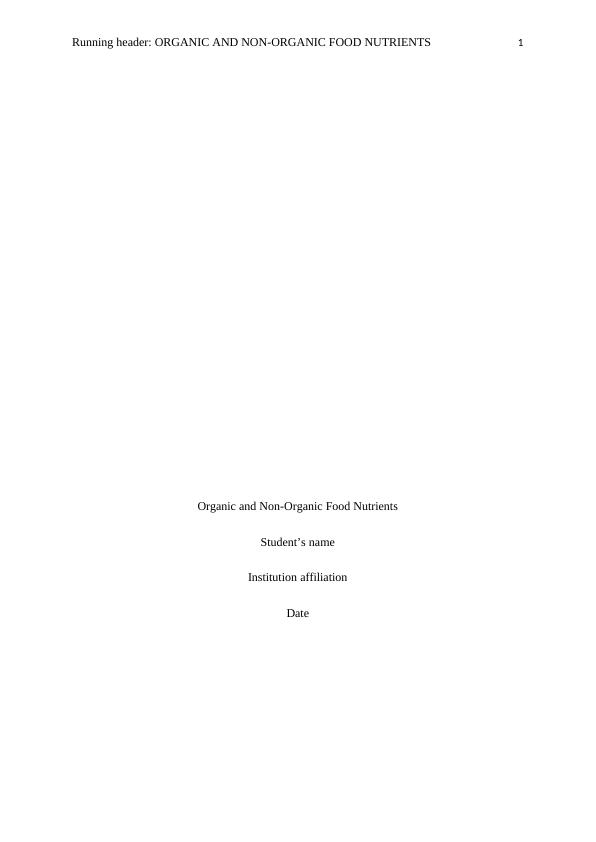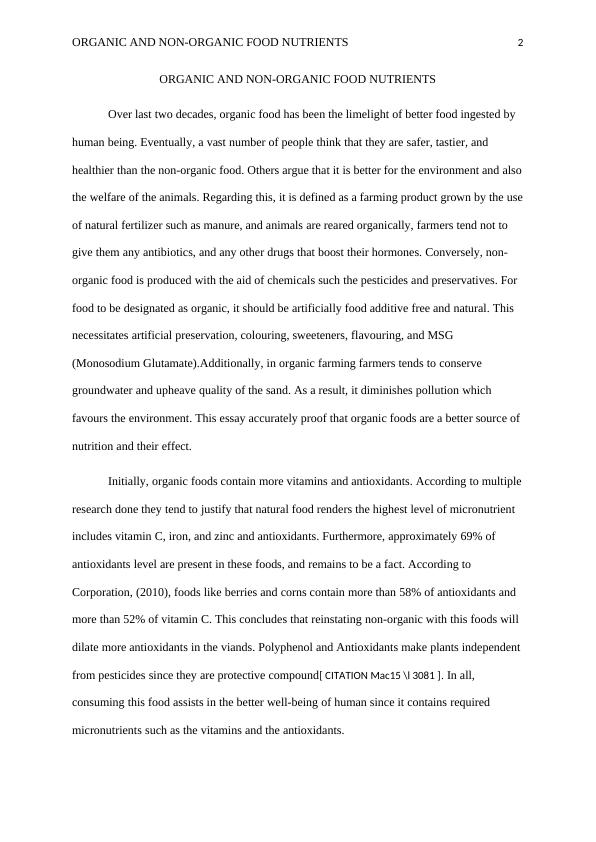Ask a question from expert
Organic and Non Organic Food Nutrients
8 Pages2089 Words382 Views
Added on 2020-05-03
Organic and Non Organic Food Nutrients
Added on 2020-05-03
BookmarkShareRelated Documents
Running header: ORGANIC AND NON-ORGANIC FOOD NUTRIENTS1Organic and Non-Organic Food NutrientsStudent’s name Institution affiliationDate

ORGANIC AND NON-ORGANIC FOOD NUTRIENTS2ORGANIC AND NON-ORGANIC FOOD NUTRIENTSOver last two decades, organic food has been the limelight of better food ingested by human being. Eventually, a vast number of people think that they are safer, tastier, and healthier than the non-organic food. Others argue that it is better for the environment and alsothe welfare of the animals. Regarding this, it is defined as a farming product grown by the useof natural fertilizer such as manure, and animals are reared organically, farmers tend not to give them any antibiotics, and any other drugs that boost their hormones. Conversely, non-organic food is produced with the aid of chemicals such the pesticides and preservatives. For food to be designated as organic, it should be artificially food additive free and natural. This necessitates artificial preservation, colouring, sweeteners, flavouring, and MSG (Monosodium Glutamate).Additionally, in organic farming farmers tends to conserve groundwater and upheave quality of the sand. As a result, it diminishes pollution which favours the environment. This essay accurately proof that organic foods are a better source of nutrition and their effect.Initially, organic foods contain more vitamins and antioxidants. According to multipleresearch done they tend to justify that natural food renders the highest level of micronutrient includes vitamin C, iron, and zinc and antioxidants. Furthermore, approximately 69% of antioxidants level are present in these foods, and remains to be a fact. According to Corporation, (2010), foods like berries and corns contain more than 58% of antioxidants and more than 52% of vitamin C. This concludes that reinstating non-organic with this foods will dilate more antioxidants in the viands. Polyphenol and Antioxidants make plants independentfrom pesticides since they are protective compound[ CITATION Mac15 \l 3081 ]. In all, consuming this food assists in the better well-being of human since it contains required micronutrients such as the vitamins and the antioxidants.

ORGANIC AND NON-ORGANIC FOOD NUTRIENTS3Subsequently, with regard to non-organic foods, vitamins and antioxidants present areof less quantity as compared to organic food. Since they are sprayed with pesticides, which perform the same function as phytochemicals, which are produced by antioxidant that is important to both plants and human health (Wexler, 2015). These foods tend not to provide it because they are dependent on the chemicals. Furthermore, pesticides are also harmful to human health and act as food poisoning when ingested. Additionally, use of food additives reduces nutrients such as vitamin C, Irons (2, 3, 4, and 5), and Zinc. These nutrients are essential in human health and if they are absent immune system of a body is negatively affected (Haugen & Musser, 2012). Chemicals found in these foods are bulking agent, starch,hydrogenated fats, and emulsifiers they cause various health disorder like cancer, stroke and high blood pressure. As a result, this kind of foods is not healthy to our health since they contain more chemicals and fewer nutrients.Secondly, Organic foods like dairy and milk contain fattier acids. They may include a higher quantity of omega three fatty acids, vitamin E, Iron, and both carotenoid seven and nine. All these are important to human health, for instance, Omega three fatty acid plays a significant role in the development and average growth of the body, and healthy brain function(What is Organic Food, and is it Better Than Non-Organic? 2016). They also lessen the risk of heart disorder to an individual. Additionally, Fish oil is an example of Omega three, and it comprises of eicosapentaenoic and docosahexaenoic acids, which advocates in managing and preventing heart disease. According to Cacioppo, (2014) it also aids in reducing blood pressure and speculations of having a stoke. Vitamin E is an example of antioxidant rebuilding and protecting body tissues from radicle materials that are harmful to organs, tissues, and organs this is its primary function. Organic milk contains less iodine and selenium, and these two minerals are vital for health. Consequently, for one to maintain a

End of preview
Want to access all the pages? Upload your documents or become a member.
Related Documents
Genetically Modified Foods: Benefits and Disadvantageslg...
|7
|1317
|269
Problems in Food Production and Sustainabilitylg...
|9
|2932
|163
Principles of Marketing: Organic Food Market Analysislg...
|11
|3355
|83